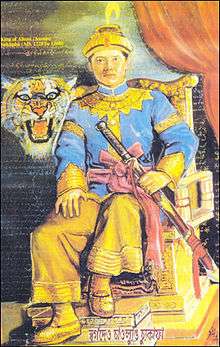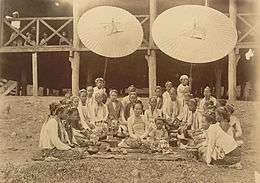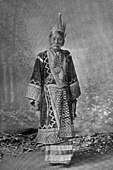Chao Pha
Chao Pha or Chao Fa (literally meaning "lord of the heavens"[1][2] Thai: เจ้าฟ้า, Shan: ၸဝ်ႈၾႃႉ, Assamese: স্বৰ্গদেউ) was a royal title used by the hereditary rulers of the Tai peoples of Mong Dun, Mong Shan, Mong Mao, kingdoms of Mueang Thai and Tai-Khamti people. It is the Thai equivalent.[1] Chao means "master" or "lord", and Fa means "sky" or "heaven". According to local chronicles, some fiefdoms of saophas date from as early as the 2nd century BCE; however, the earlier sections of these chronicles are generally agreed to be legendary.[3]
| Chao Pha | |
|---|---|
 | |
| Last holder | Chao Pha Purandar Singha |
| Status | Not used in Modern days |
| A Tai Nobility Title used by Ahom Kings, Shan Chiefs, Thai Prince / Princess and Khamti Chief. | |
Overview
During British colonial rule, there were 14 to 16 saophas at a time, each ruling a highly autonomous state, until 1922 when the Federated Shan States were formed and the saophas' powers were reduced. However, they nominally kept their positions as well as their courts and still played a role in local administration until they collectively relinquished their titles in favour of the Union of Burma in 1959.[1]Shan is the semi-independent Shan States (Mong, Shan: မိူင်း, pronounced [mə́ŋ]) in what today is Eastern Myanmar (Burma). It may also be used for rulers of similar Tai/Dai states in neighbouring countries, notably including China's Yunnan Province.[1].
Gallery
See also
References
- Donald M. Seekins (2006). Historical Dictionary of Burma (Myanmar). Scarecrow Press. entry Sawbwa, p. 391.
- Barbara Watson Andaya; Leonard Y. Andaya (2015). A History of Early Modern Southeast Asia, 1400-1830. Cambridge University Press. p. 170.
- "Pinkaew Leungaramsri. - Women, Nation, and the Ambivalence of Subversive Identification along the Thai-Burmese Border - Sojourn: Journal of Social Issues in Southeast Asia 21:1". muse.jhu.edu. Retrieved 2008-03-27.
_at_the_Durbar%2C_Delhi%2C_India.jpg)

